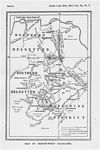Swynnerton, Charles Francis Massy
Photo: Rawdon Goodier
Map showing Swynnerton's travels in Gazaland and many of the places mentioned in the biography
List: records (8) | collections (8) | images (0) | determinations (0) | confirmations (0) made by Frank Swynnerton
The above links show records made of species which occur in Zimbabwe. The actual records may have been made anywhere.
Summarise: records by year Map: records by QDS
General Information
Date of birth: 3 Dec 1877 Date of death: 8 Jun 1938 Biography
Naturalist and EcologistFrank Swynnerton was born in Lowestoft but spent his early years in India where his father was a senior chaplain to the Indian Army. He returned to England for his education, the later part at Lancing College where he developed an enthusiasm for natural history. Despite obtaining entrance to Oxford University in 1897 he decided to emigrate to South Africa. In Natal he met a fellow naturalist, Guy Marshall, who encourage him to move to Southern Rhodesia where Marshall had already established himself in Salisbury in 1893. Initially Swynnerton worked in a store part owned by Marshall but finding such work uncongenial moved to the Melsetter district as a farm manager. In 1900 he transferred to manage Gungunyana Farm by Chirinda Forest, which was later bought by Marshall in 1902. Swynnerton's life centred around the farm at Gungunyana and the surrounding area of Gazaland for the next 19 years in the course of which he acquainted himself thoroughly with the local natural history. He was probably encouraged in this by Guy Marshall who developed a very distinguished career as an entomologist (a world expert on weevils), becoming Director of the Commonwealth Institute of Entomology in London. Swynnerton's plant collecting seems to have started by 1903 but was intensified in 1905 and 1906. He sent a large number of herbarium specimens to the British Museum in London which were noted as exhibiting "a precision in localisation and notes on economic uses which made this collection a model one" (1). Swynnerton's contribution to the botany of Zimbabwe culminated in the paper on the Flora of Gazaland published by the Linnaean Society in 1911 (2) in which British Museum botanists described his collected plant material, including many new species, some of which were named after him, accompanied by "notes by Mr Swynnerton" describing his journeys. The latter included the description of a visit to the Chimanimani Mountains in 1906. The 50 or so Swynnerton collection numbers in the 1961 checklist of the Chimanimani flora (3) indicate that he made subsequent visits there and indeed Flora Zambesiaca citations indicate that he returned there in 1907 and 1908. His contribution to the knowledge of the Chirinda Forest flora is well summarised in Lyn Mullin's account in the Chirinda Forest Guide (4 ). Swynnerton also studied the birds of Gazaland, publishing articles on them in Ibis for 1907 and 1908 (5). He made extensive collections of insect specimens, many of which are to be found in the British Museum. He travelled to London in 1907 when he was elected to membership of the Linnaean Society and made further visits in 1911, 1915 and 1923. In 1918 Swynnerton suffered from a breakdown in health which caused him to give up farming. However this did not appear to diminish his energy because in the same year he "arranged to carry out a preliminary investigation of the habits and distribution of the tsetse flies in the northern region of the Mossurize District (roughly the border area surrounding the Mozambique Sitatonga Hills). This is not the place to discuss Swynnerton's work on the study and control of tsetse which was to be his main concern for the rest of his life but it is interesting to note that in his paper on the Mossurize work (6 ) he comments "the practical study of tsetse is, I am convinced, a matter for the botanist and oecologist rather than the unaided entomologist". Indeed the North Mossurize paper is a fascinating exercise in holistic thinking in which he brings together the botany, entomology and human history of the area. Its importance for later tsetse work is well summarised by Ford (7). According to Guy Marshall (8) "it contained a number of original ideas and threw an entirely new light on the ecological aspects of the complex tsetse problem". It is worth noting that by this time Marshall was the chief editor of the Bulletin of Entomological Research. and one senses that he was continuing to act as Swynnerton's friend and mentor. Next year, 1919, Swynnerton left Gungunyana and took up a post as the first game warden in Tanganyika, in which capacity he soon became involved in the game/tsetse relationship. His work in this area eventually led to his appointment, in 1929, as director of the new department of tsetse research. In 1936 he published his major work on The Tsetse Flies of East Africa (9). In 1937 he was awarded the CMG for his work but the following year was killed in a plane crash while travelling to receive it. His obituary in Nature was written by Sir Guy Marshall. References
R.Goodier 2007 |

